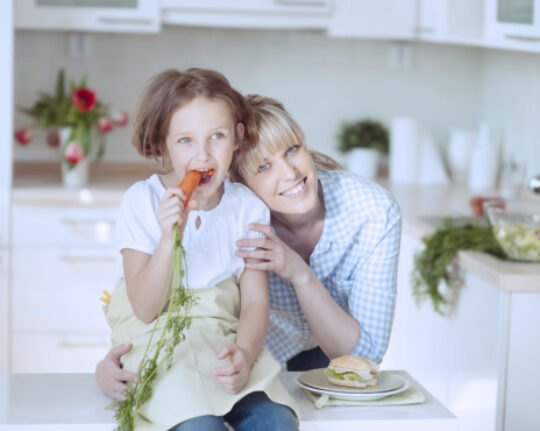Feeding Your Preschooler - Ages 4 to 5 Years

Nutrition during preschool years is important for kids' growth and learning, and to provide energy for high activity levels. Here are some suggestions for proper nutrition during these years.
What Should My Preschooler Be Eating?
Your preschooler is now able to feed him or herself and is able to try a wide variety of foods. Always offer different choices for your child to eat. Make food appealing and fun for your child, and make sure your child is trying each of the food groups, including:
- Fruits
- Grains
- Meat
- Milk
- Vegetables
How Much Should My Preschooler Eat?
Your job is to decide what foods are offered and when and where they are eaten. Let your child decide which of the foods offered he or she will eat, and how much to eat.
The following table gives guidelines for how much your child should be eating each day.
Grain Group
Your preschooler should get at least six servings of grains each day. This could include:
- 1 slice of bread
- 4-6 crackers
- 1/2 cup cooked rice, pasta or cereal
- 1/2 bun, muffin or bagel
Fruit and Vegetable Group
Fruits and vegetables are also an important nutritional element for your child. Make sure he or she gets at least 5 servings each day. Examples are:
- 1/2 cup cooked, canned, or chopped raw
- 1/2 - 1 small fruit/vegetable
- 1/2 cup juice
Milk Group
Milk and other dairy products provide many nutrients for your preschooler. At least three servings each day will keep your child healthy. Try:
- 3/4 cup milk or yogurt
- 3/4 ounce of cheese
Meat Group
Two servings each day of meat will supply your children with valuable protein. Let your preschoolers try a variety of meat sources, including:
- 1-3 tablespoons lean meat, chicken, fish
- 4-5 tablespoons dry beans and peas
- 1 egg
Fat Group
Your child also needs fat sources to continue to grow. 3-4 servings of fat each day is sufficient, and could include:
- 1 teaspoon margarine, butter, oils
What Are Some Good Snacks for My Preschooler?
Your children are bound to get hungry between meals. Be sure to choose snacks that are healthy and filling, including:
- Grain group: Animal crackers, dry cereal, graham crackers, toast, air-popped popcorn
- Vegetable group: Raw vegetables cut up in strips
- Fruit group: Fresh fruit cut up for finger food, canned fruit, dried fruit
- Milk group: Cheese, cottage cheese, string cheese, yogurt, milk (plain or flavored), pudding
- Meat group: Peanut butter, hard-boiled eggs, lean lunch meat slices, tuna salad
Is There Anything I Shouldn't Feed My Preschooler?
At snack or meal time, make sure you give your children safe foods to try. Many common foods prevent health risks such as choking or allergic reactions.
Choking Risks
It is important to be careful with foods that may cause choking. Here are some examples of foods that can pose a choking hazard:
- Slippery foods such as whole grapes, large pieces of meat, poultry, hot dogs, candy and cough drops.
- Small, hard foods such as nuts, seeds, popcorn, chips, pretzels, raw carrots and raisins.
- Sticky foods such as peanut butter and marshmallows.
- Always cut up foods into small pieces and watch your child while he or she is eating.
Potential Food Allergies
Also, your child may have some food allergies. Although many children grow out of food allergies, it is still important to monitor when your children eat foods that pose a potential allergy risk. These foods include:
- Eggs
- Fish
- Milk
- Peanuts and other nuts
- Shellfish
- Soybeans
- Wheat
Additional Food Tips
Finally, always remember to set a good example of healthy eating for your children. Also plan regular meals and snacks, and give your child enough time to eat. View the listing below for other healthy eating tips to use in your home:
- Plan a quiet time before meals and snacks. Kids eat better when they are relaxed.
- Don't use food as a reward.
- Involve your children in making the food.
- Use child-size plates, cups, forks and spoons.
